MMH356: Change Management Report - Australia Post Case Study
VerifiedAdded on 2023/06/12
|18
|4721
|66
Report
AI Summary
This report provides an in-depth analysis of organizational change management, focusing on Australia Post as a case study. It addresses the needs for organizational change, particularly in service provision and revenue generation, which necessitate the implementation of strategic changes. The report applies Lewin’s Change Management Model (Unfreeze, Change, Refreeze) and McKinsey’s 7-S Model to evaluate and recommend improvements in Australia Post's operations. The analysis covers various aspects such as adapting to the increasing demand for online parcel handling, enhancing customer satisfaction, and improving competitiveness against private courier services. The report concludes by highlighting how embracing these organizational changes can lead to sustainability and enhanced market position for Australia Post. The document is available on Desklib, a platform offering a range of study tools and resources for students.
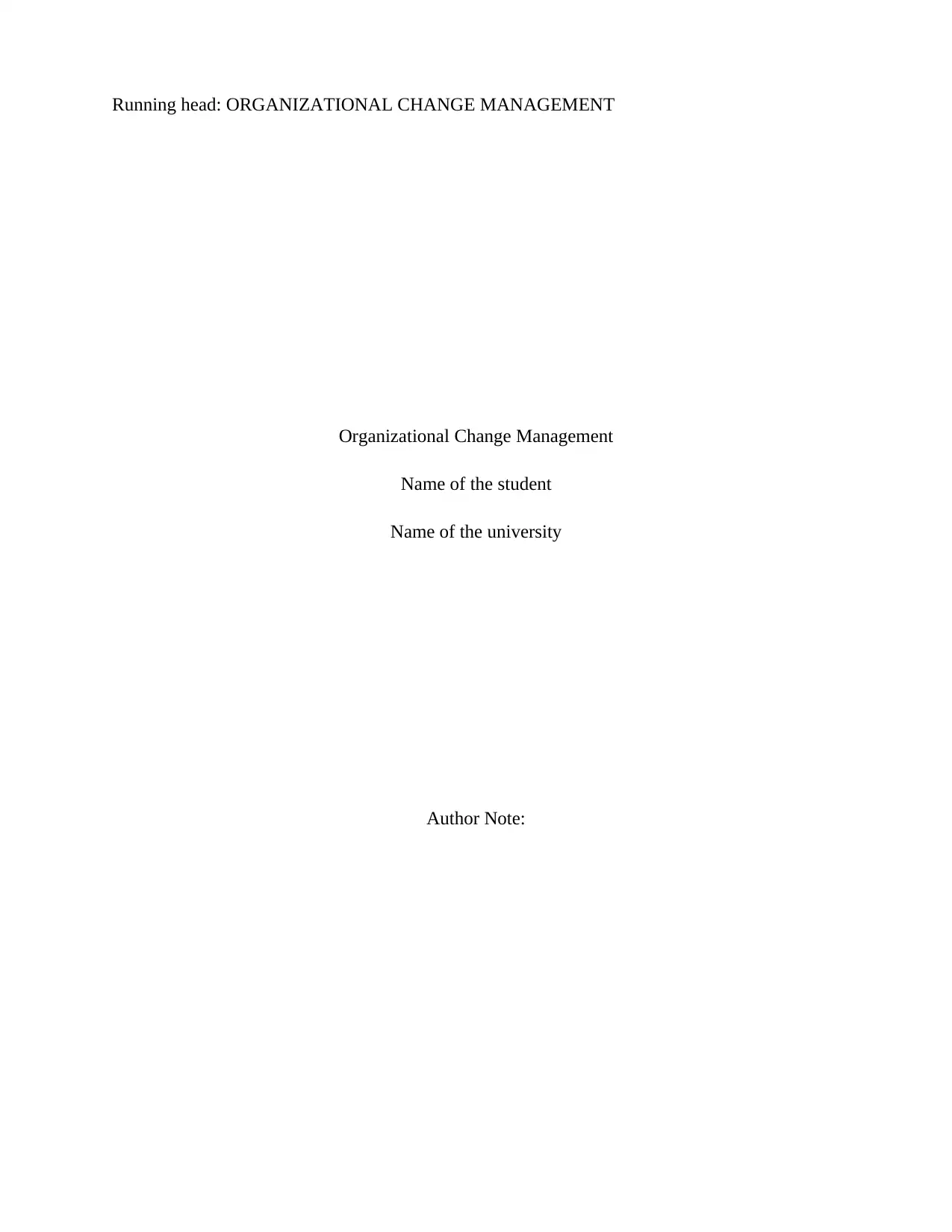
Running head: ORGANIZATIONAL CHANGE MANAGEMENT
Organizational Change Management
Name of the student
Name of the university
Author Note:
Organizational Change Management
Name of the student
Name of the university
Author Note:
Paraphrase This Document
Need a fresh take? Get an instant paraphrase of this document with our AI Paraphraser
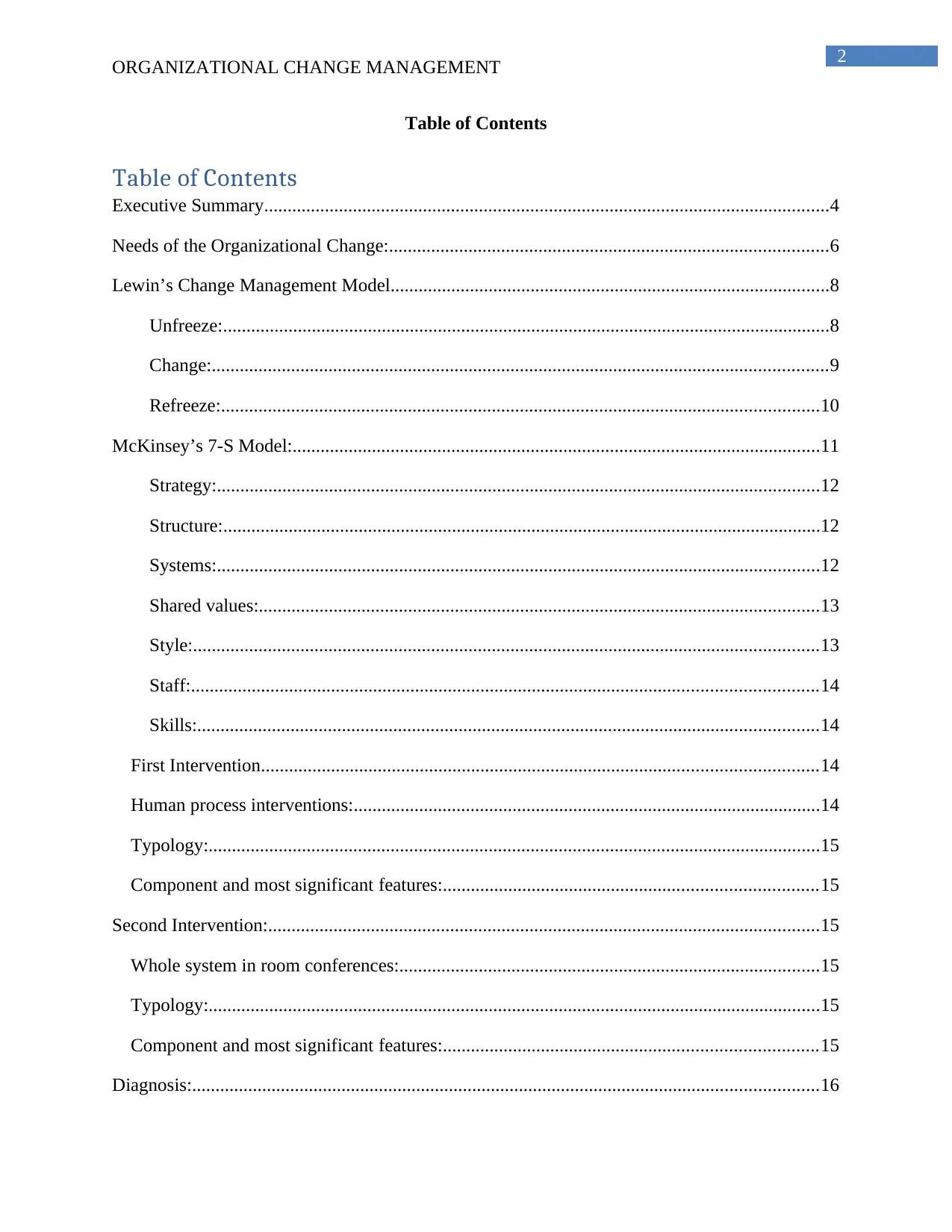
2
ORGANIZATIONAL CHANGE MANAGEMENT
Table of Contents
Table of Contents
Executive Summary.........................................................................................................................4
Needs of the Organizational Change:..............................................................................................6
Lewin’s Change Management Model..............................................................................................8
Unfreeze:..................................................................................................................................8
Change:....................................................................................................................................9
Refreeze:................................................................................................................................10
McKinsey’s 7-S Model:.................................................................................................................11
Strategy:.................................................................................................................................12
Structure:................................................................................................................................12
Systems:.................................................................................................................................12
Shared values:........................................................................................................................13
Style:......................................................................................................................................13
Staff:......................................................................................................................................14
Skills:.....................................................................................................................................14
First Intervention.......................................................................................................................14
Human process interventions:....................................................................................................14
Typology:...................................................................................................................................15
Component and most significant features:................................................................................15
Second Intervention:......................................................................................................................15
Whole system in room conferences:..........................................................................................15
Typology:...................................................................................................................................15
Component and most significant features:................................................................................15
Diagnosis:......................................................................................................................................16
ORGANIZATIONAL CHANGE MANAGEMENT
Table of Contents
Table of Contents
Executive Summary.........................................................................................................................4
Needs of the Organizational Change:..............................................................................................6
Lewin’s Change Management Model..............................................................................................8
Unfreeze:..................................................................................................................................8
Change:....................................................................................................................................9
Refreeze:................................................................................................................................10
McKinsey’s 7-S Model:.................................................................................................................11
Strategy:.................................................................................................................................12
Structure:................................................................................................................................12
Systems:.................................................................................................................................12
Shared values:........................................................................................................................13
Style:......................................................................................................................................13
Staff:......................................................................................................................................14
Skills:.....................................................................................................................................14
First Intervention.......................................................................................................................14
Human process interventions:....................................................................................................14
Typology:...................................................................................................................................15
Component and most significant features:................................................................................15
Second Intervention:......................................................................................................................15
Whole system in room conferences:..........................................................................................15
Typology:...................................................................................................................................15
Component and most significant features:................................................................................15
Diagnosis:......................................................................................................................................16
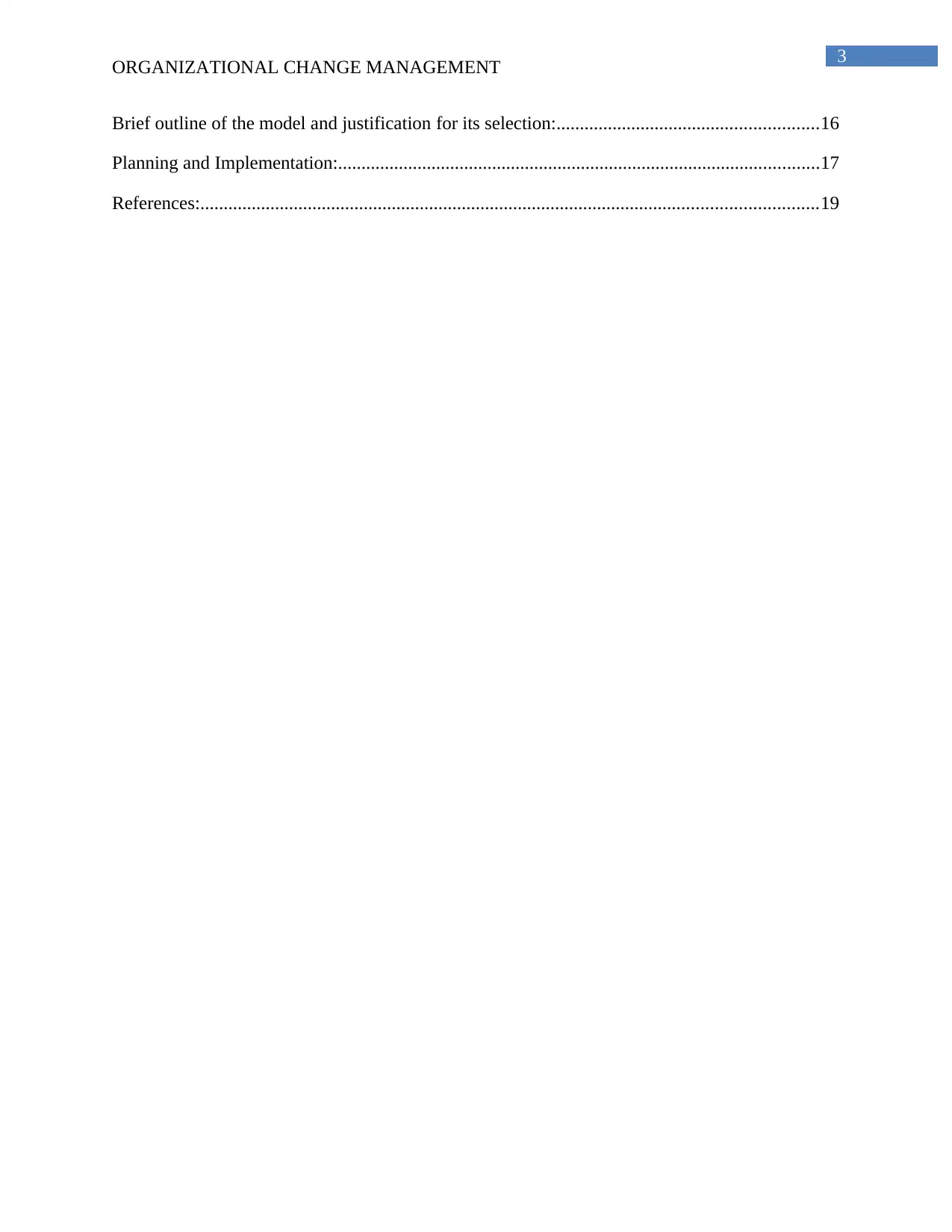
3
ORGANIZATIONAL CHANGE MANAGEMENT
Brief outline of the model and justification for its selection:........................................................16
Planning and Implementation:.......................................................................................................17
References:....................................................................................................................................19
ORGANIZATIONAL CHANGE MANAGEMENT
Brief outline of the model and justification for its selection:........................................................16
Planning and Implementation:.......................................................................................................17
References:....................................................................................................................................19
⊘ This is a preview!⊘
Do you want full access?
Subscribe today to unlock all pages.

Trusted by 1+ million students worldwide
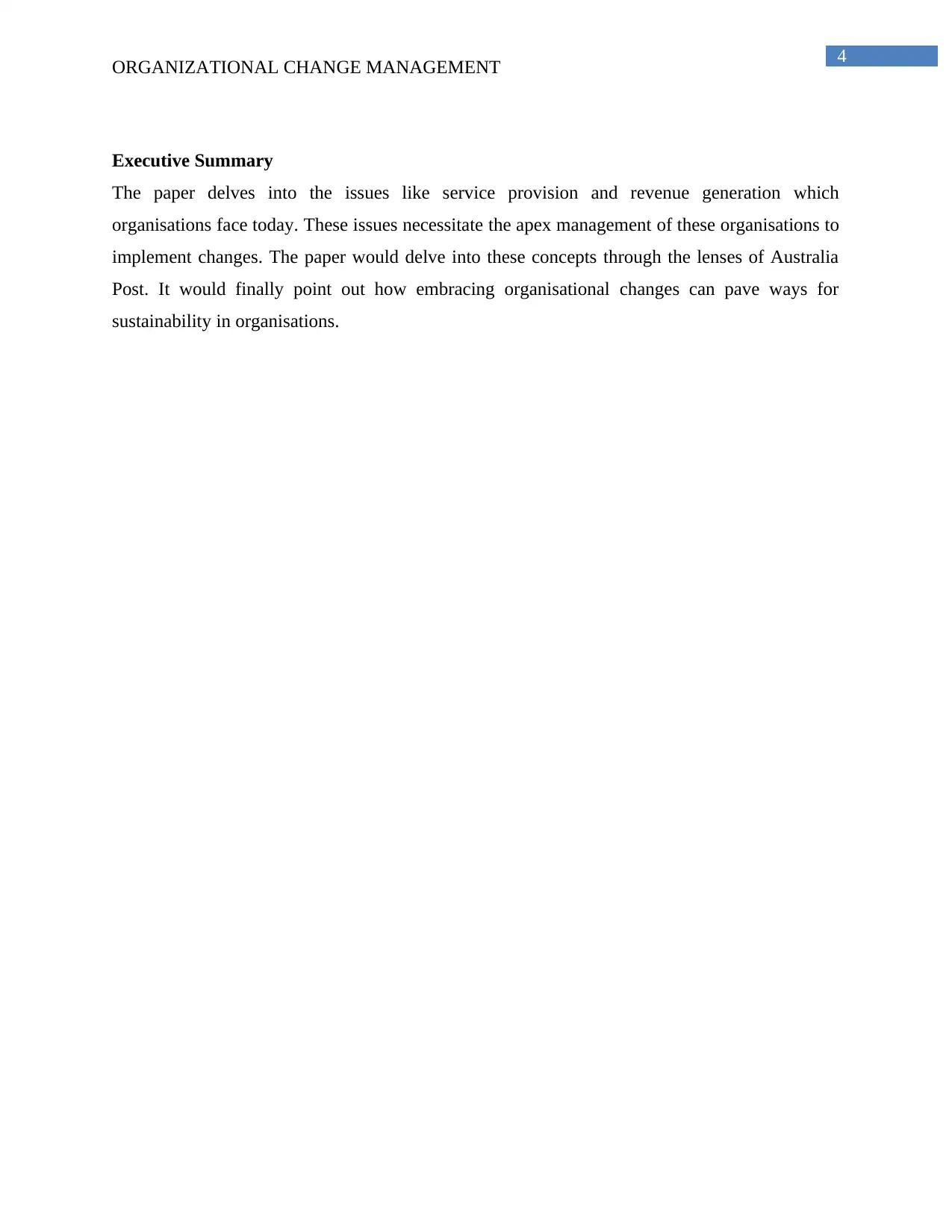
4
ORGANIZATIONAL CHANGE MANAGEMENT
Executive Summary
The paper delves into the issues like service provision and revenue generation which
organisations face today. These issues necessitate the apex management of these organisations to
implement changes. The paper would delve into these concepts through the lenses of Australia
Post. It would finally point out how embracing organisational changes can pave ways for
sustainability in organisations.
ORGANIZATIONAL CHANGE MANAGEMENT
Executive Summary
The paper delves into the issues like service provision and revenue generation which
organisations face today. These issues necessitate the apex management of these organisations to
implement changes. The paper would delve into these concepts through the lenses of Australia
Post. It would finally point out how embracing organisational changes can pave ways for
sustainability in organisations.
Paraphrase This Document
Need a fresh take? Get an instant paraphrase of this document with our AI Paraphraser
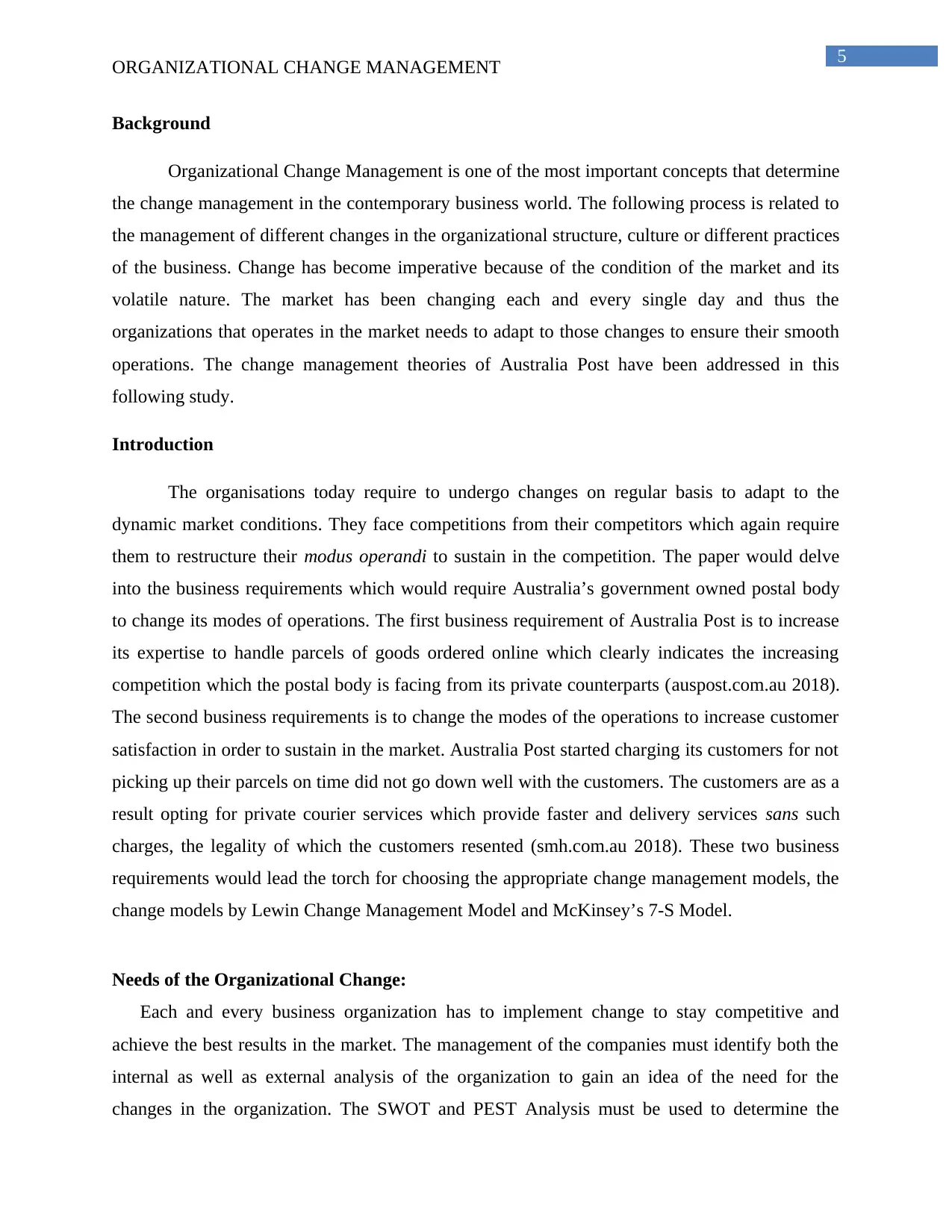
5
ORGANIZATIONAL CHANGE MANAGEMENT
Background
Organizational Change Management is one of the most important concepts that determine
the change management in the contemporary business world. The following process is related to
the management of different changes in the organizational structure, culture or different practices
of the business. Change has become imperative because of the condition of the market and its
volatile nature. The market has been changing each and every single day and thus the
organizations that operates in the market needs to adapt to those changes to ensure their smooth
operations. The change management theories of Australia Post have been addressed in this
following study.
Introduction
The organisations today require to undergo changes on regular basis to adapt to the
dynamic market conditions. They face competitions from their competitors which again require
them to restructure their modus operandi to sustain in the competition. The paper would delve
into the business requirements which would require Australia’s government owned postal body
to change its modes of operations. The first business requirement of Australia Post is to increase
its expertise to handle parcels of goods ordered online which clearly indicates the increasing
competition which the postal body is facing from its private counterparts (auspost.com.au 2018).
The second business requirements is to change the modes of the operations to increase customer
satisfaction in order to sustain in the market. Australia Post started charging its customers for not
picking up their parcels on time did not go down well with the customers. The customers are as a
result opting for private courier services which provide faster and delivery services sans such
charges, the legality of which the customers resented (smh.com.au 2018). These two business
requirements would lead the torch for choosing the appropriate change management models, the
change models by Lewin Change Management Model and McKinsey’s 7-S Model.
Needs of the Organizational Change:
Each and every business organization has to implement change to stay competitive and
achieve the best results in the market. The management of the companies must identify both the
internal as well as external analysis of the organization to gain an idea of the need for the
changes in the organization. The SWOT and PEST Analysis must be used to determine the
ORGANIZATIONAL CHANGE MANAGEMENT
Background
Organizational Change Management is one of the most important concepts that determine
the change management in the contemporary business world. The following process is related to
the management of different changes in the organizational structure, culture or different practices
of the business. Change has become imperative because of the condition of the market and its
volatile nature. The market has been changing each and every single day and thus the
organizations that operates in the market needs to adapt to those changes to ensure their smooth
operations. The change management theories of Australia Post have been addressed in this
following study.
Introduction
The organisations today require to undergo changes on regular basis to adapt to the
dynamic market conditions. They face competitions from their competitors which again require
them to restructure their modus operandi to sustain in the competition. The paper would delve
into the business requirements which would require Australia’s government owned postal body
to change its modes of operations. The first business requirement of Australia Post is to increase
its expertise to handle parcels of goods ordered online which clearly indicates the increasing
competition which the postal body is facing from its private counterparts (auspost.com.au 2018).
The second business requirements is to change the modes of the operations to increase customer
satisfaction in order to sustain in the market. Australia Post started charging its customers for not
picking up their parcels on time did not go down well with the customers. The customers are as a
result opting for private courier services which provide faster and delivery services sans such
charges, the legality of which the customers resented (smh.com.au 2018). These two business
requirements would lead the torch for choosing the appropriate change management models, the
change models by Lewin Change Management Model and McKinsey’s 7-S Model.
Needs of the Organizational Change:
Each and every business organization has to implement change to stay competitive and
achieve the best results in the market. The management of the companies must identify both the
internal as well as external analysis of the organization to gain an idea of the need for the
changes in the organization. The SWOT and PEST Analysis must be used to determine the
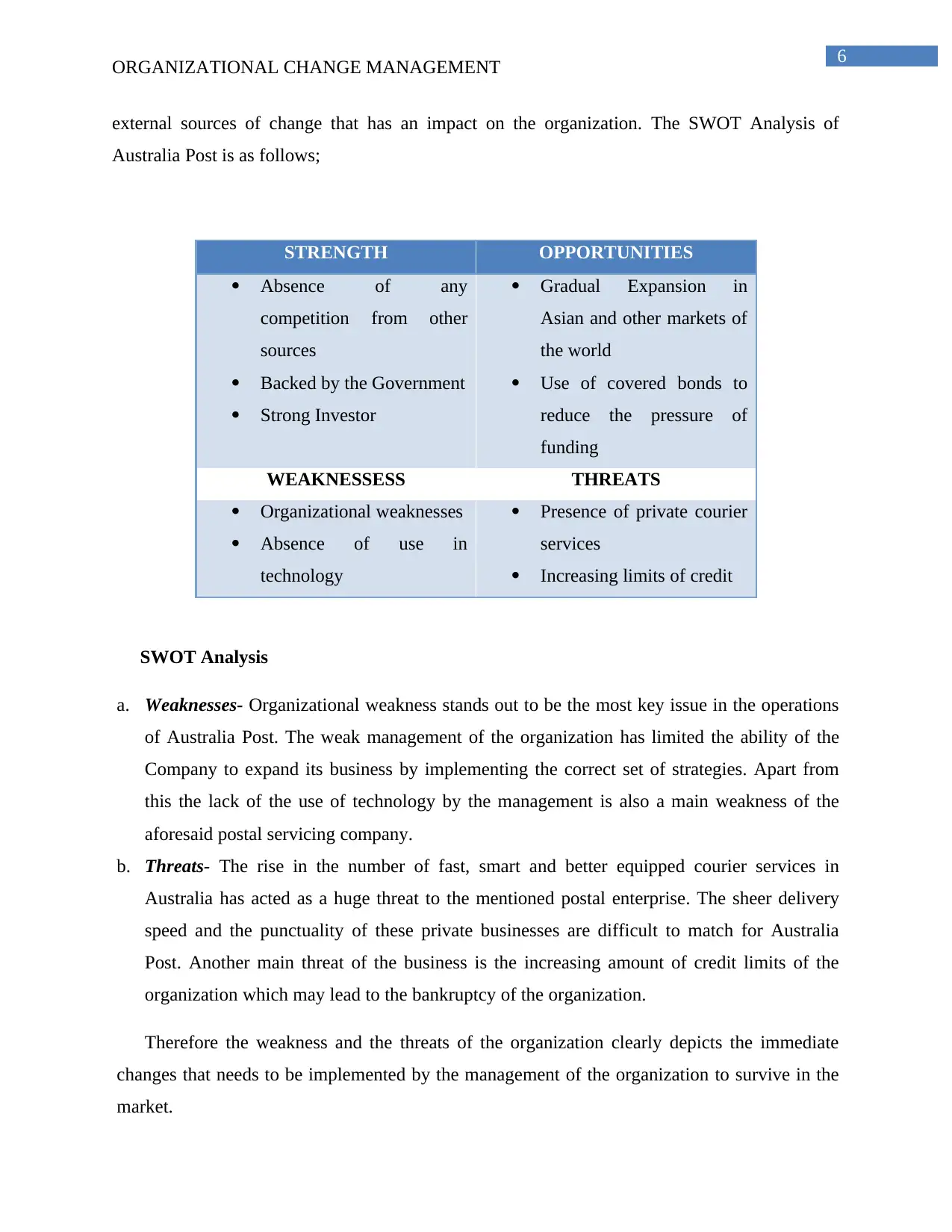
6
ORGANIZATIONAL CHANGE MANAGEMENT
external sources of change that has an impact on the organization. The SWOT Analysis of
Australia Post is as follows;
STRENGTH OPPORTUNITIES
Absence of any
competition from other
sources
Backed by the Government
Strong Investor
Gradual Expansion in
Asian and other markets of
the world
Use of covered bonds to
reduce the pressure of
funding
WEAKNESSESS THREATS
Organizational weaknesses
Absence of use in
technology
Presence of private courier
services
Increasing limits of credit
SWOT Analysis
a. Weaknesses- Organizational weakness stands out to be the most key issue in the operations
of Australia Post. The weak management of the organization has limited the ability of the
Company to expand its business by implementing the correct set of strategies. Apart from
this the lack of the use of technology by the management is also a main weakness of the
aforesaid postal servicing company.
b. Threats- The rise in the number of fast, smart and better equipped courier services in
Australia has acted as a huge threat to the mentioned postal enterprise. The sheer delivery
speed and the punctuality of these private businesses are difficult to match for Australia
Post. Another main threat of the business is the increasing amount of credit limits of the
organization which may lead to the bankruptcy of the organization.
Therefore the weakness and the threats of the organization clearly depicts the immediate
changes that needs to be implemented by the management of the organization to survive in the
market.
ORGANIZATIONAL CHANGE MANAGEMENT
external sources of change that has an impact on the organization. The SWOT Analysis of
Australia Post is as follows;
STRENGTH OPPORTUNITIES
Absence of any
competition from other
sources
Backed by the Government
Strong Investor
Gradual Expansion in
Asian and other markets of
the world
Use of covered bonds to
reduce the pressure of
funding
WEAKNESSESS THREATS
Organizational weaknesses
Absence of use in
technology
Presence of private courier
services
Increasing limits of credit
SWOT Analysis
a. Weaknesses- Organizational weakness stands out to be the most key issue in the operations
of Australia Post. The weak management of the organization has limited the ability of the
Company to expand its business by implementing the correct set of strategies. Apart from
this the lack of the use of technology by the management is also a main weakness of the
aforesaid postal servicing company.
b. Threats- The rise in the number of fast, smart and better equipped courier services in
Australia has acted as a huge threat to the mentioned postal enterprise. The sheer delivery
speed and the punctuality of these private businesses are difficult to match for Australia
Post. Another main threat of the business is the increasing amount of credit limits of the
organization which may lead to the bankruptcy of the organization.
Therefore the weakness and the threats of the organization clearly depicts the immediate
changes that needs to be implemented by the management of the organization to survive in the
market.
⊘ This is a preview!⊘
Do you want full access?
Subscribe today to unlock all pages.

Trusted by 1+ million students worldwide
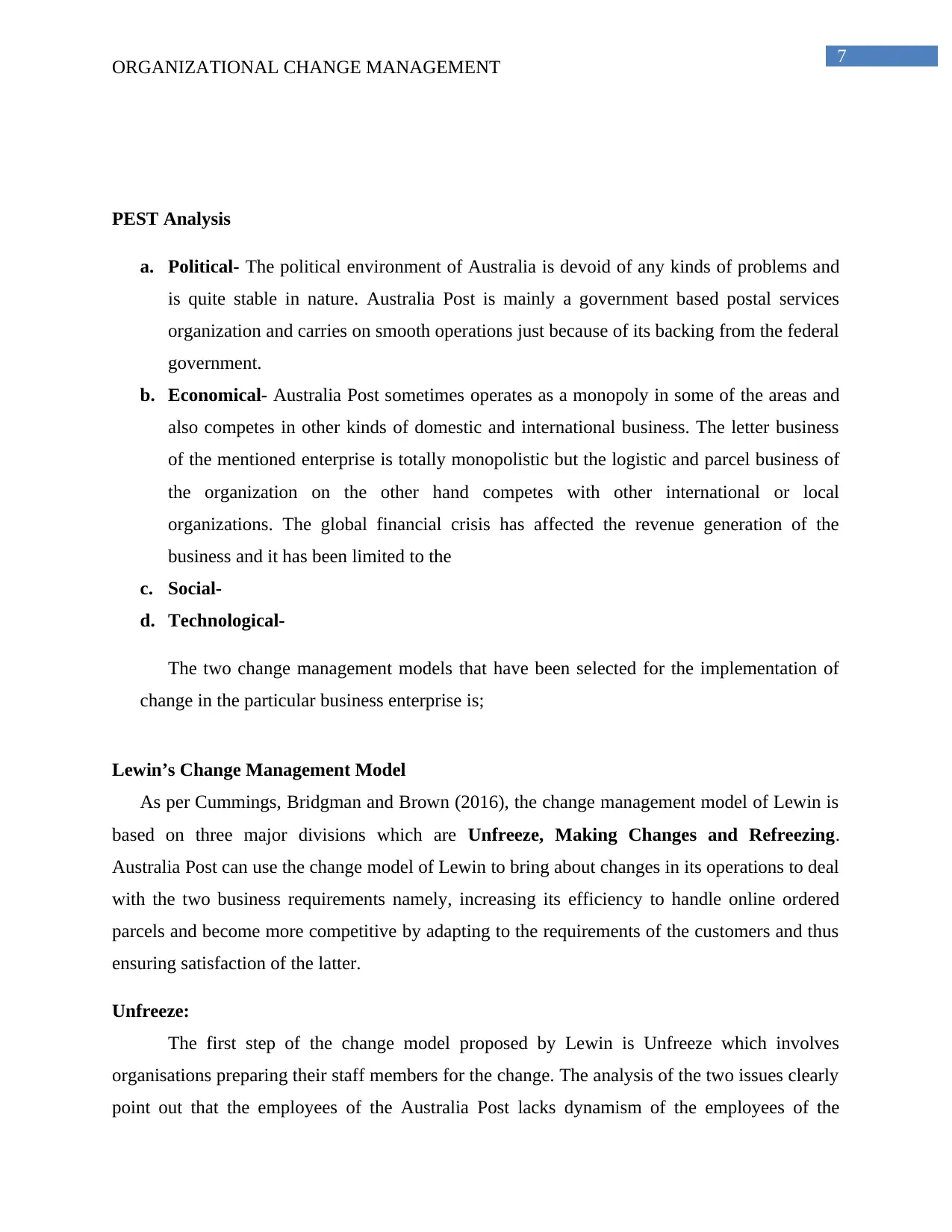
7
ORGANIZATIONAL CHANGE MANAGEMENT
PEST Analysis
a. Political- The political environment of Australia is devoid of any kinds of problems and
is quite stable in nature. Australia Post is mainly a government based postal services
organization and carries on smooth operations just because of its backing from the federal
government.
b. Economical- Australia Post sometimes operates as a monopoly in some of the areas and
also competes in other kinds of domestic and international business. The letter business
of the mentioned enterprise is totally monopolistic but the logistic and parcel business of
the organization on the other hand competes with other international or local
organizations. The global financial crisis has affected the revenue generation of the
business and it has been limited to the
c. Social-
d. Technological-
The two change management models that have been selected for the implementation of
change in the particular business enterprise is;
Lewin’s Change Management Model
As per Cummings, Bridgman and Brown (2016), the change management model of Lewin is
based on three major divisions which are Unfreeze, Making Changes and Refreezing.
Australia Post can use the change model of Lewin to bring about changes in its operations to deal
with the two business requirements namely, increasing its efficiency to handle online ordered
parcels and become more competitive by adapting to the requirements of the customers and thus
ensuring satisfaction of the latter.
Unfreeze:
The first step of the change model proposed by Lewin is Unfreeze which involves
organisations preparing their staff members for the change. The analysis of the two issues clearly
point out that the employees of the Australia Post lacks dynamism of the employees of the
ORGANIZATIONAL CHANGE MANAGEMENT
PEST Analysis
a. Political- The political environment of Australia is devoid of any kinds of problems and
is quite stable in nature. Australia Post is mainly a government based postal services
organization and carries on smooth operations just because of its backing from the federal
government.
b. Economical- Australia Post sometimes operates as a monopoly in some of the areas and
also competes in other kinds of domestic and international business. The letter business
of the mentioned enterprise is totally monopolistic but the logistic and parcel business of
the organization on the other hand competes with other international or local
organizations. The global financial crisis has affected the revenue generation of the
business and it has been limited to the
c. Social-
d. Technological-
The two change management models that have been selected for the implementation of
change in the particular business enterprise is;
Lewin’s Change Management Model
As per Cummings, Bridgman and Brown (2016), the change management model of Lewin is
based on three major divisions which are Unfreeze, Making Changes and Refreezing.
Australia Post can use the change model of Lewin to bring about changes in its operations to deal
with the two business requirements namely, increasing its efficiency to handle online ordered
parcels and become more competitive by adapting to the requirements of the customers and thus
ensuring satisfaction of the latter.
Unfreeze:
The first step of the change model proposed by Lewin is Unfreeze which involves
organisations preparing their staff members for the change. The analysis of the two issues clearly
point out that the employees of the Australia Post lacks dynamism of the employees of the
Paraphrase This Document
Need a fresh take? Get an instant paraphrase of this document with our AI Paraphraser
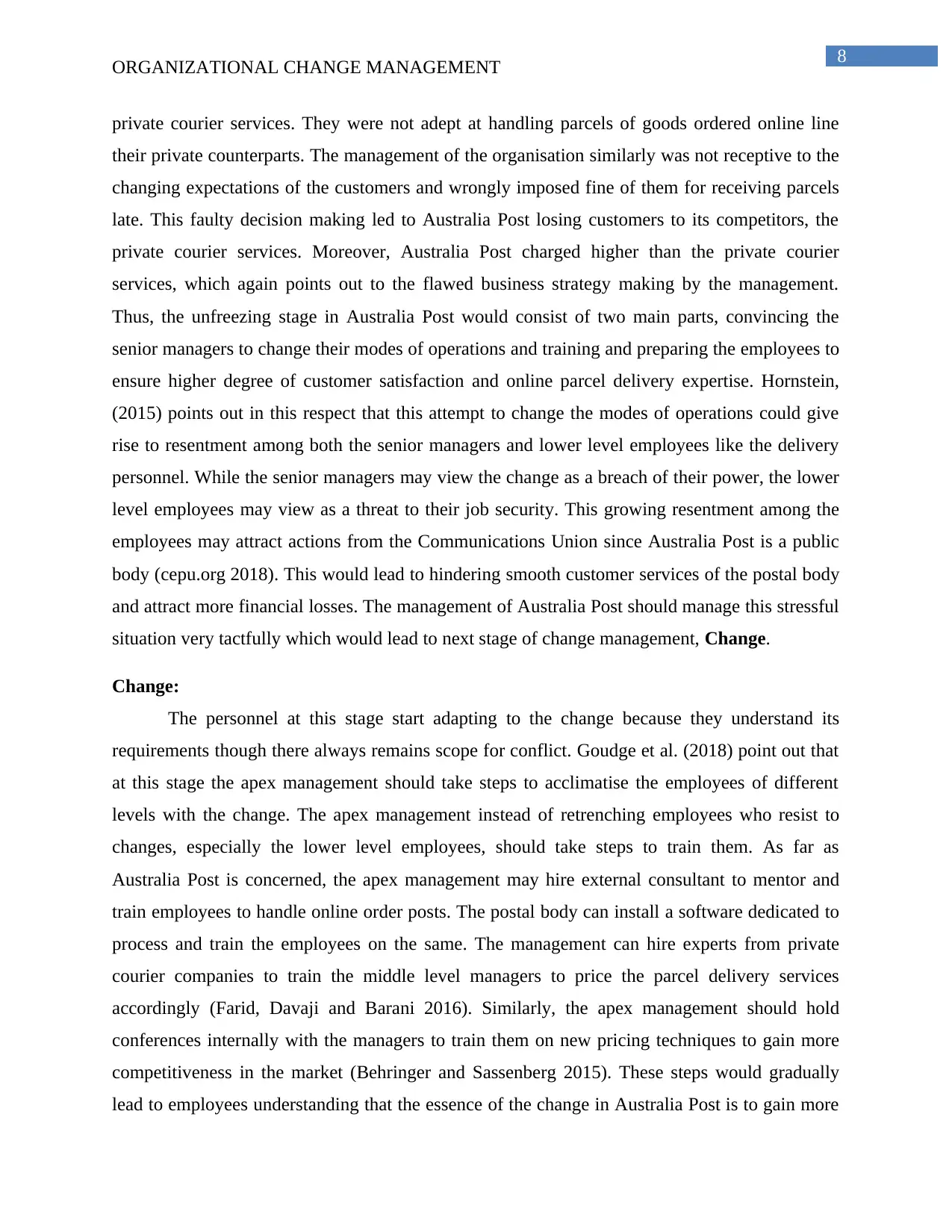
8
ORGANIZATIONAL CHANGE MANAGEMENT
private courier services. They were not adept at handling parcels of goods ordered online line
their private counterparts. The management of the organisation similarly was not receptive to the
changing expectations of the customers and wrongly imposed fine of them for receiving parcels
late. This faulty decision making led to Australia Post losing customers to its competitors, the
private courier services. Moreover, Australia Post charged higher than the private courier
services, which again points out to the flawed business strategy making by the management.
Thus, the unfreezing stage in Australia Post would consist of two main parts, convincing the
senior managers to change their modes of operations and training and preparing the employees to
ensure higher degree of customer satisfaction and online parcel delivery expertise. Hornstein,
(2015) points out in this respect that this attempt to change the modes of operations could give
rise to resentment among both the senior managers and lower level employees like the delivery
personnel. While the senior managers may view the change as a breach of their power, the lower
level employees may view as a threat to their job security. This growing resentment among the
employees may attract actions from the Communications Union since Australia Post is a public
body (cepu.org 2018). This would lead to hindering smooth customer services of the postal body
and attract more financial losses. The management of Australia Post should manage this stressful
situation very tactfully which would lead to next stage of change management, Change.
Change:
The personnel at this stage start adapting to the change because they understand its
requirements though there always remains scope for conflict. Goudge et al. (2018) point out that
at this stage the apex management should take steps to acclimatise the employees of different
levels with the change. The apex management instead of retrenching employees who resist to
changes, especially the lower level employees, should take steps to train them. As far as
Australia Post is concerned, the apex management may hire external consultant to mentor and
train employees to handle online order posts. The postal body can install a software dedicated to
process and train the employees on the same. The management can hire experts from private
courier companies to train the middle level managers to price the parcel delivery services
accordingly (Farid, Davaji and Barani 2016). Similarly, the apex management should hold
conferences internally with the managers to train them on new pricing techniques to gain more
competitiveness in the market (Behringer and Sassenberg 2015). These steps would gradually
lead to employees understanding that the essence of the change in Australia Post is to gain more
ORGANIZATIONAL CHANGE MANAGEMENT
private courier services. They were not adept at handling parcels of goods ordered online line
their private counterparts. The management of the organisation similarly was not receptive to the
changing expectations of the customers and wrongly imposed fine of them for receiving parcels
late. This faulty decision making led to Australia Post losing customers to its competitors, the
private courier services. Moreover, Australia Post charged higher than the private courier
services, which again points out to the flawed business strategy making by the management.
Thus, the unfreezing stage in Australia Post would consist of two main parts, convincing the
senior managers to change their modes of operations and training and preparing the employees to
ensure higher degree of customer satisfaction and online parcel delivery expertise. Hornstein,
(2015) points out in this respect that this attempt to change the modes of operations could give
rise to resentment among both the senior managers and lower level employees like the delivery
personnel. While the senior managers may view the change as a breach of their power, the lower
level employees may view as a threat to their job security. This growing resentment among the
employees may attract actions from the Communications Union since Australia Post is a public
body (cepu.org 2018). This would lead to hindering smooth customer services of the postal body
and attract more financial losses. The management of Australia Post should manage this stressful
situation very tactfully which would lead to next stage of change management, Change.
Change:
The personnel at this stage start adapting to the change because they understand its
requirements though there always remains scope for conflict. Goudge et al. (2018) point out that
at this stage the apex management should take steps to acclimatise the employees of different
levels with the change. The apex management instead of retrenching employees who resist to
changes, especially the lower level employees, should take steps to train them. As far as
Australia Post is concerned, the apex management may hire external consultant to mentor and
train employees to handle online order posts. The postal body can install a software dedicated to
process and train the employees on the same. The management can hire experts from private
courier companies to train the middle level managers to price the parcel delivery services
accordingly (Farid, Davaji and Barani 2016). Similarly, the apex management should hold
conferences internally with the managers to train them on new pricing techniques to gain more
competitiveness in the market (Behringer and Sassenberg 2015). These steps would gradually
lead to employees understanding that the essence of the change in Australia Post is to gain more
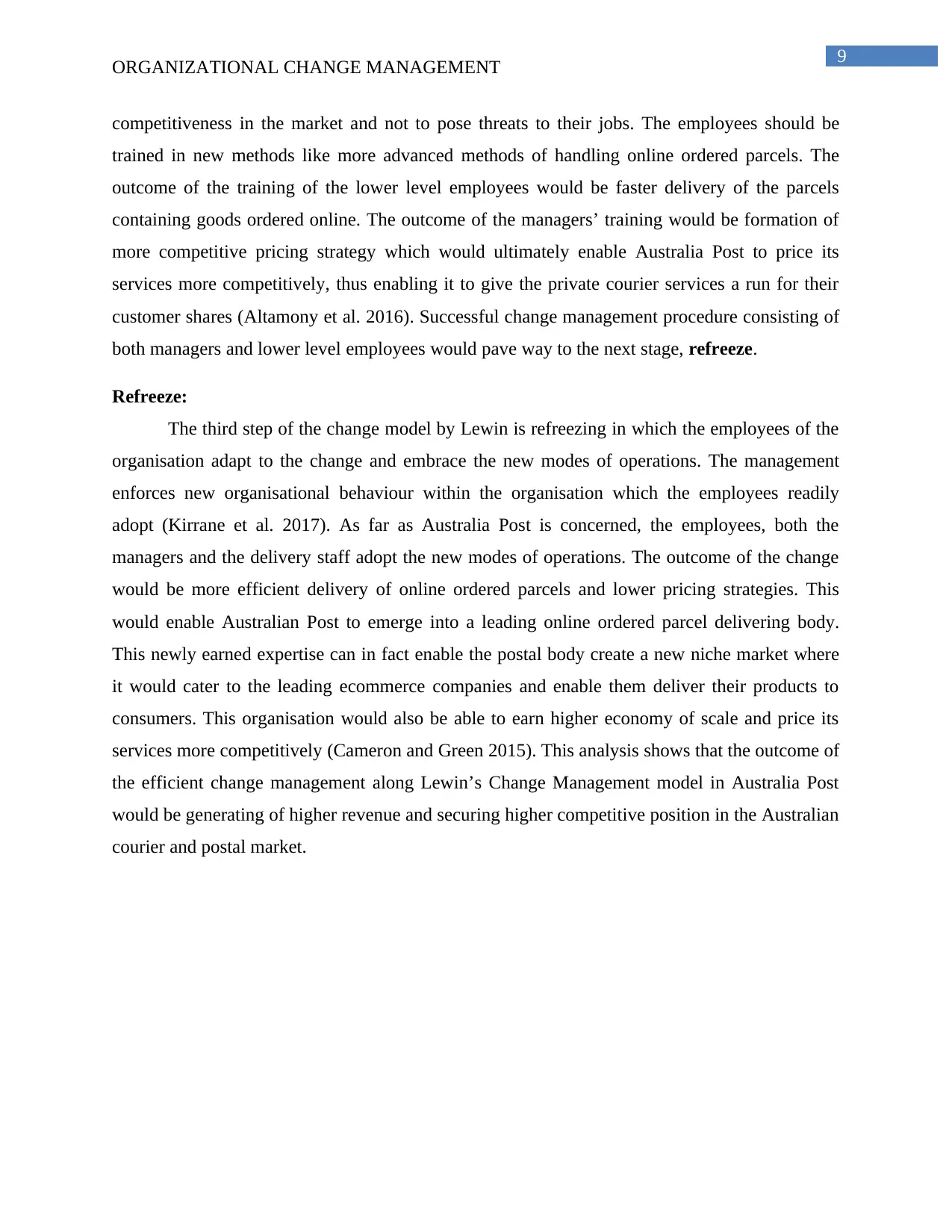
9
ORGANIZATIONAL CHANGE MANAGEMENT
competitiveness in the market and not to pose threats to their jobs. The employees should be
trained in new methods like more advanced methods of handling online ordered parcels. The
outcome of the training of the lower level employees would be faster delivery of the parcels
containing goods ordered online. The outcome of the managers’ training would be formation of
more competitive pricing strategy which would ultimately enable Australia Post to price its
services more competitively, thus enabling it to give the private courier services a run for their
customer shares (Altamony et al. 2016). Successful change management procedure consisting of
both managers and lower level employees would pave way to the next stage, refreeze.
Refreeze:
The third step of the change model by Lewin is refreezing in which the employees of the
organisation adapt to the change and embrace the new modes of operations. The management
enforces new organisational behaviour within the organisation which the employees readily
adopt (Kirrane et al. 2017). As far as Australia Post is concerned, the employees, both the
managers and the delivery staff adopt the new modes of operations. The outcome of the change
would be more efficient delivery of online ordered parcels and lower pricing strategies. This
would enable Australian Post to emerge into a leading online ordered parcel delivering body.
This newly earned expertise can in fact enable the postal body create a new niche market where
it would cater to the leading ecommerce companies and enable them deliver their products to
consumers. This organisation would also be able to earn higher economy of scale and price its
services more competitively (Cameron and Green 2015). This analysis shows that the outcome of
the efficient change management along Lewin’s Change Management model in Australia Post
would be generating of higher revenue and securing higher competitive position in the Australian
courier and postal market.
ORGANIZATIONAL CHANGE MANAGEMENT
competitiveness in the market and not to pose threats to their jobs. The employees should be
trained in new methods like more advanced methods of handling online ordered parcels. The
outcome of the training of the lower level employees would be faster delivery of the parcels
containing goods ordered online. The outcome of the managers’ training would be formation of
more competitive pricing strategy which would ultimately enable Australia Post to price its
services more competitively, thus enabling it to give the private courier services a run for their
customer shares (Altamony et al. 2016). Successful change management procedure consisting of
both managers and lower level employees would pave way to the next stage, refreeze.
Refreeze:
The third step of the change model by Lewin is refreezing in which the employees of the
organisation adapt to the change and embrace the new modes of operations. The management
enforces new organisational behaviour within the organisation which the employees readily
adopt (Kirrane et al. 2017). As far as Australia Post is concerned, the employees, both the
managers and the delivery staff adopt the new modes of operations. The outcome of the change
would be more efficient delivery of online ordered parcels and lower pricing strategies. This
would enable Australian Post to emerge into a leading online ordered parcel delivering body.
This newly earned expertise can in fact enable the postal body create a new niche market where
it would cater to the leading ecommerce companies and enable them deliver their products to
consumers. This organisation would also be able to earn higher economy of scale and price its
services more competitively (Cameron and Green 2015). This analysis shows that the outcome of
the efficient change management along Lewin’s Change Management model in Australia Post
would be generating of higher revenue and securing higher competitive position in the Australian
courier and postal market.
⊘ This is a preview!⊘
Do you want full access?
Subscribe today to unlock all pages.

Trusted by 1+ million students worldwide
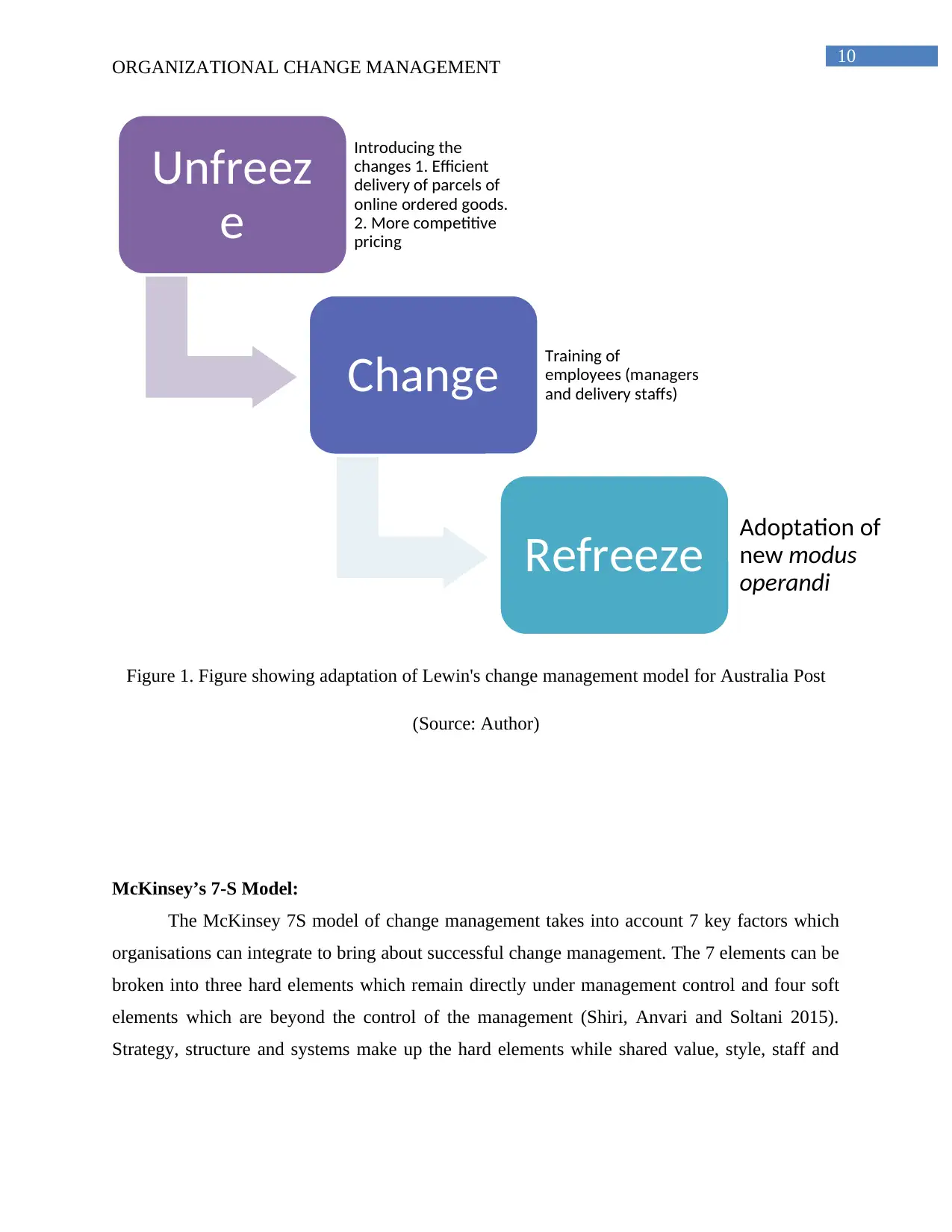
10
ORGANIZATIONAL CHANGE MANAGEMENT
Figure 1. Figure showing adaptation of Lewin's change management model for Australia Post
(Source: Author)
McKinsey’s 7-S Model:
The McKinsey 7S model of change management takes into account 7 key factors which
organisations can integrate to bring about successful change management. The 7 elements can be
broken into three hard elements which remain directly under management control and four soft
elements which are beyond the control of the management (Shiri, Anvari and Soltani 2015).
Strategy, structure and systems make up the hard elements while shared value, style, staff and
Unfreez
e
Introducing the
changes 1. Efficient
delivery of parcels of
online ordered goods.
2. More competitive
pricing
Change Training of
employees (managers
and delivery staffs)
Refreeze Adoptation of
new modus
operandi
ORGANIZATIONAL CHANGE MANAGEMENT
Figure 1. Figure showing adaptation of Lewin's change management model for Australia Post
(Source: Author)
McKinsey’s 7-S Model:
The McKinsey 7S model of change management takes into account 7 key factors which
organisations can integrate to bring about successful change management. The 7 elements can be
broken into three hard elements which remain directly under management control and four soft
elements which are beyond the control of the management (Shiri, Anvari and Soltani 2015).
Strategy, structure and systems make up the hard elements while shared value, style, staff and
Unfreez
e
Introducing the
changes 1. Efficient
delivery of parcels of
online ordered goods.
2. More competitive
pricing
Change Training of
employees (managers
and delivery staffs)
Refreeze Adoptation of
new modus
operandi
Paraphrase This Document
Need a fresh take? Get an instant paraphrase of this document with our AI Paraphraser
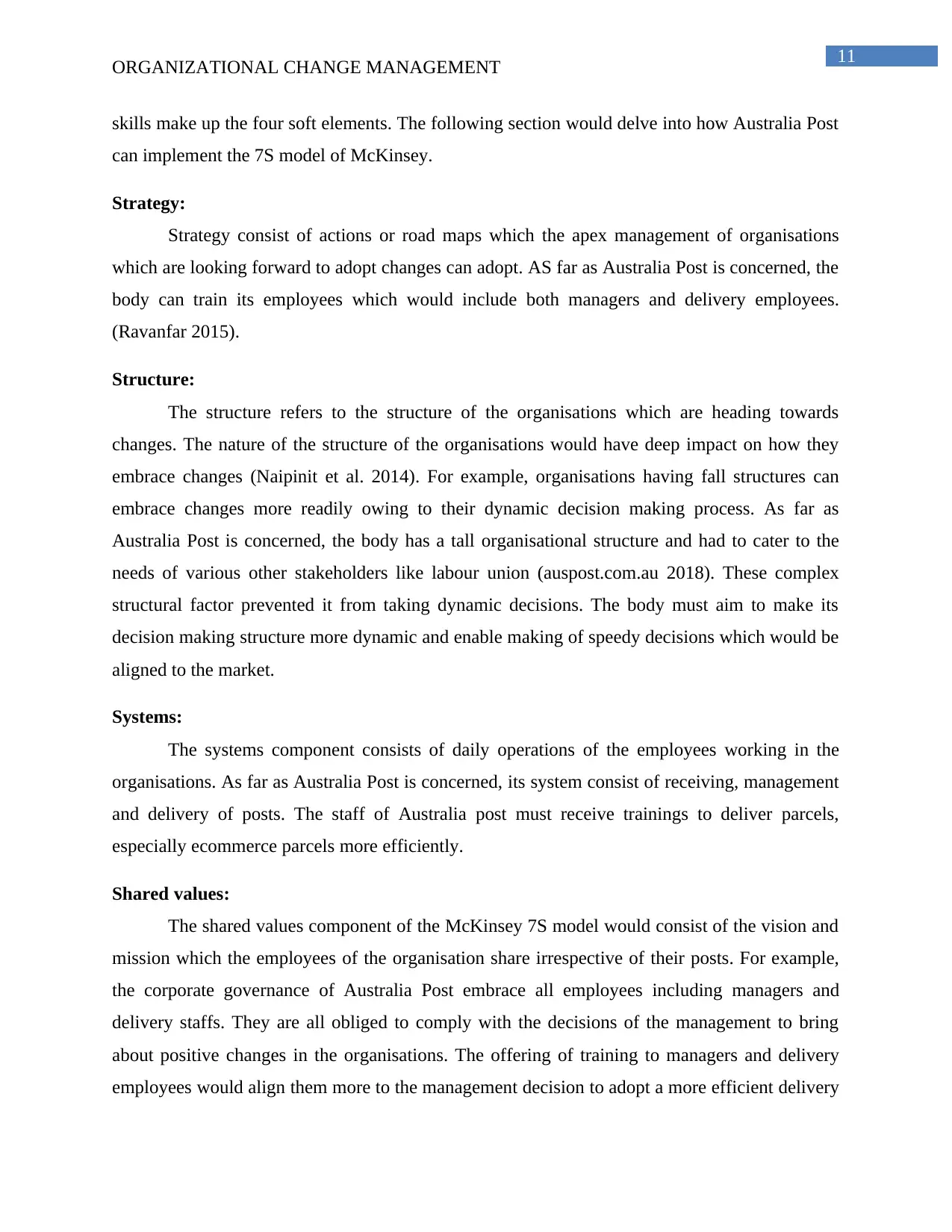
11
ORGANIZATIONAL CHANGE MANAGEMENT
skills make up the four soft elements. The following section would delve into how Australia Post
can implement the 7S model of McKinsey.
Strategy:
Strategy consist of actions or road maps which the apex management of organisations
which are looking forward to adopt changes can adopt. AS far as Australia Post is concerned, the
body can train its employees which would include both managers and delivery employees.
(Ravanfar 2015).
Structure:
The structure refers to the structure of the organisations which are heading towards
changes. The nature of the structure of the organisations would have deep impact on how they
embrace changes (Naipinit et al. 2014). For example, organisations having fall structures can
embrace changes more readily owing to their dynamic decision making process. As far as
Australia Post is concerned, the body has a tall organisational structure and had to cater to the
needs of various other stakeholders like labour union (auspost.com.au 2018). These complex
structural factor prevented it from taking dynamic decisions. The body must aim to make its
decision making structure more dynamic and enable making of speedy decisions which would be
aligned to the market.
Systems:
The systems component consists of daily operations of the employees working in the
organisations. As far as Australia Post is concerned, its system consist of receiving, management
and delivery of posts. The staff of Australia post must receive trainings to deliver parcels,
especially ecommerce parcels more efficiently.
Shared values:
The shared values component of the McKinsey 7S model would consist of the vision and
mission which the employees of the organisation share irrespective of their posts. For example,
the corporate governance of Australia Post embrace all employees including managers and
delivery staffs. They are all obliged to comply with the decisions of the management to bring
about positive changes in the organisations. The offering of training to managers and delivery
employees would align them more to the management decision to adopt a more efficient delivery
ORGANIZATIONAL CHANGE MANAGEMENT
skills make up the four soft elements. The following section would delve into how Australia Post
can implement the 7S model of McKinsey.
Strategy:
Strategy consist of actions or road maps which the apex management of organisations
which are looking forward to adopt changes can adopt. AS far as Australia Post is concerned, the
body can train its employees which would include both managers and delivery employees.
(Ravanfar 2015).
Structure:
The structure refers to the structure of the organisations which are heading towards
changes. The nature of the structure of the organisations would have deep impact on how they
embrace changes (Naipinit et al. 2014). For example, organisations having fall structures can
embrace changes more readily owing to their dynamic decision making process. As far as
Australia Post is concerned, the body has a tall organisational structure and had to cater to the
needs of various other stakeholders like labour union (auspost.com.au 2018). These complex
structural factor prevented it from taking dynamic decisions. The body must aim to make its
decision making structure more dynamic and enable making of speedy decisions which would be
aligned to the market.
Systems:
The systems component consists of daily operations of the employees working in the
organisations. As far as Australia Post is concerned, its system consist of receiving, management
and delivery of posts. The staff of Australia post must receive trainings to deliver parcels,
especially ecommerce parcels more efficiently.
Shared values:
The shared values component of the McKinsey 7S model would consist of the vision and
mission which the employees of the organisation share irrespective of their posts. For example,
the corporate governance of Australia Post embrace all employees including managers and
delivery staffs. They are all obliged to comply with the decisions of the management to bring
about positive changes in the organisations. The offering of training to managers and delivery
employees would align them more to the management decision to adopt a more efficient delivery
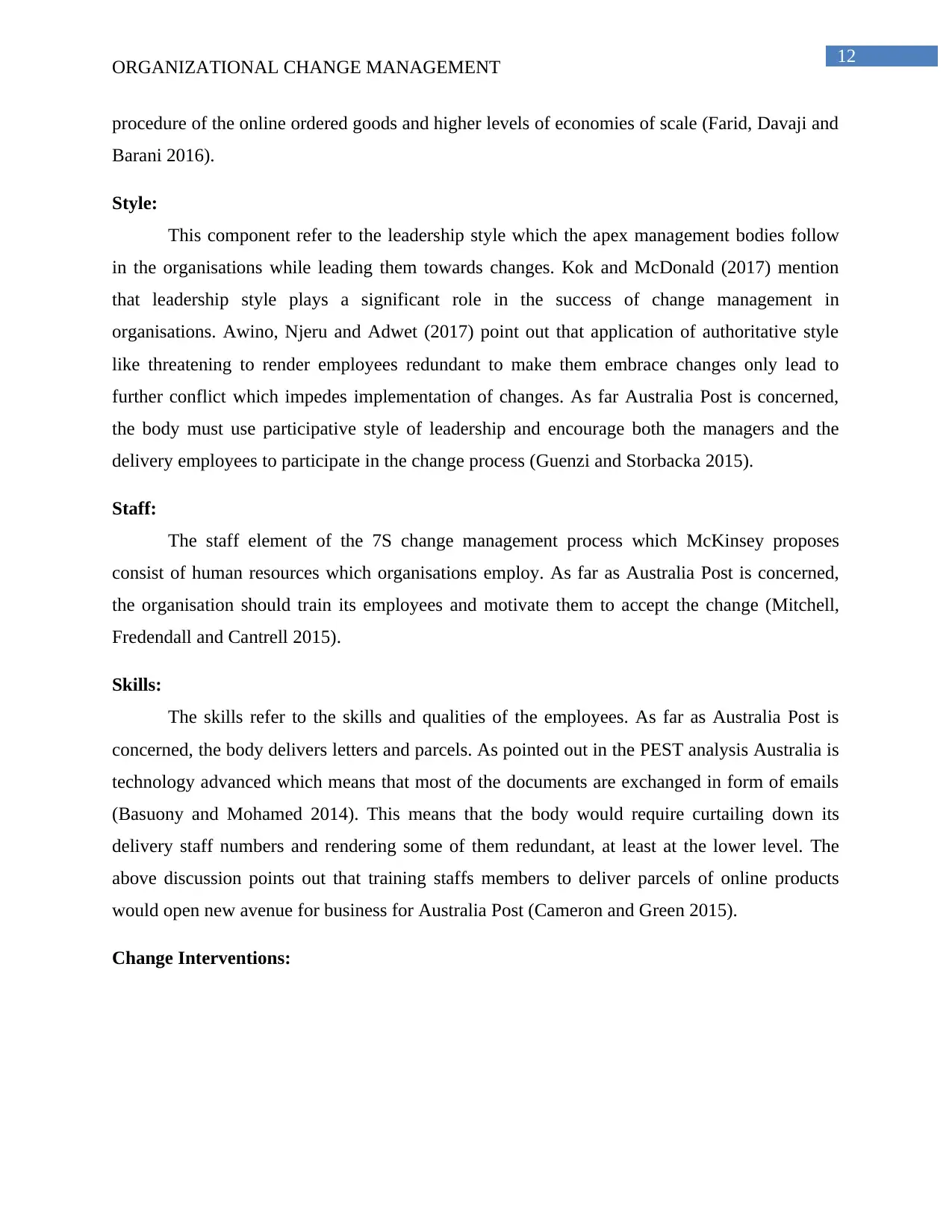
12
ORGANIZATIONAL CHANGE MANAGEMENT
procedure of the online ordered goods and higher levels of economies of scale (Farid, Davaji and
Barani 2016).
Style:
This component refer to the leadership style which the apex management bodies follow
in the organisations while leading them towards changes. Kok and McDonald (2017) mention
that leadership style plays a significant role in the success of change management in
organisations. Awino, Njeru and Adwet (2017) point out that application of authoritative style
like threatening to render employees redundant to make them embrace changes only lead to
further conflict which impedes implementation of changes. As far Australia Post is concerned,
the body must use participative style of leadership and encourage both the managers and the
delivery employees to participate in the change process (Guenzi and Storbacka 2015).
Staff:
The staff element of the 7S change management process which McKinsey proposes
consist of human resources which organisations employ. As far as Australia Post is concerned,
the organisation should train its employees and motivate them to accept the change (Mitchell,
Fredendall and Cantrell 2015).
Skills:
The skills refer to the skills and qualities of the employees. As far as Australia Post is
concerned, the body delivers letters and parcels. As pointed out in the PEST analysis Australia is
technology advanced which means that most of the documents are exchanged in form of emails
(Basuony and Mohamed 2014). This means that the body would require curtailing down its
delivery staff numbers and rendering some of them redundant, at least at the lower level. The
above discussion points out that training staffs members to deliver parcels of online products
would open new avenue for business for Australia Post (Cameron and Green 2015).
Change Interventions:
ORGANIZATIONAL CHANGE MANAGEMENT
procedure of the online ordered goods and higher levels of economies of scale (Farid, Davaji and
Barani 2016).
Style:
This component refer to the leadership style which the apex management bodies follow
in the organisations while leading them towards changes. Kok and McDonald (2017) mention
that leadership style plays a significant role in the success of change management in
organisations. Awino, Njeru and Adwet (2017) point out that application of authoritative style
like threatening to render employees redundant to make them embrace changes only lead to
further conflict which impedes implementation of changes. As far Australia Post is concerned,
the body must use participative style of leadership and encourage both the managers and the
delivery employees to participate in the change process (Guenzi and Storbacka 2015).
Staff:
The staff element of the 7S change management process which McKinsey proposes
consist of human resources which organisations employ. As far as Australia Post is concerned,
the organisation should train its employees and motivate them to accept the change (Mitchell,
Fredendall and Cantrell 2015).
Skills:
The skills refer to the skills and qualities of the employees. As far as Australia Post is
concerned, the body delivers letters and parcels. As pointed out in the PEST analysis Australia is
technology advanced which means that most of the documents are exchanged in form of emails
(Basuony and Mohamed 2014). This means that the body would require curtailing down its
delivery staff numbers and rendering some of them redundant, at least at the lower level. The
above discussion points out that training staffs members to deliver parcels of online products
would open new avenue for business for Australia Post (Cameron and Green 2015).
Change Interventions:
⊘ This is a preview!⊘
Do you want full access?
Subscribe today to unlock all pages.

Trusted by 1+ million students worldwide
1 out of 18
Related Documents
Your All-in-One AI-Powered Toolkit for Academic Success.
+13062052269
info@desklib.com
Available 24*7 on WhatsApp / Email
![[object Object]](/_next/static/media/star-bottom.7253800d.svg)
Unlock your academic potential
Copyright © 2020–2025 A2Z Services. All Rights Reserved. Developed and managed by ZUCOL.




